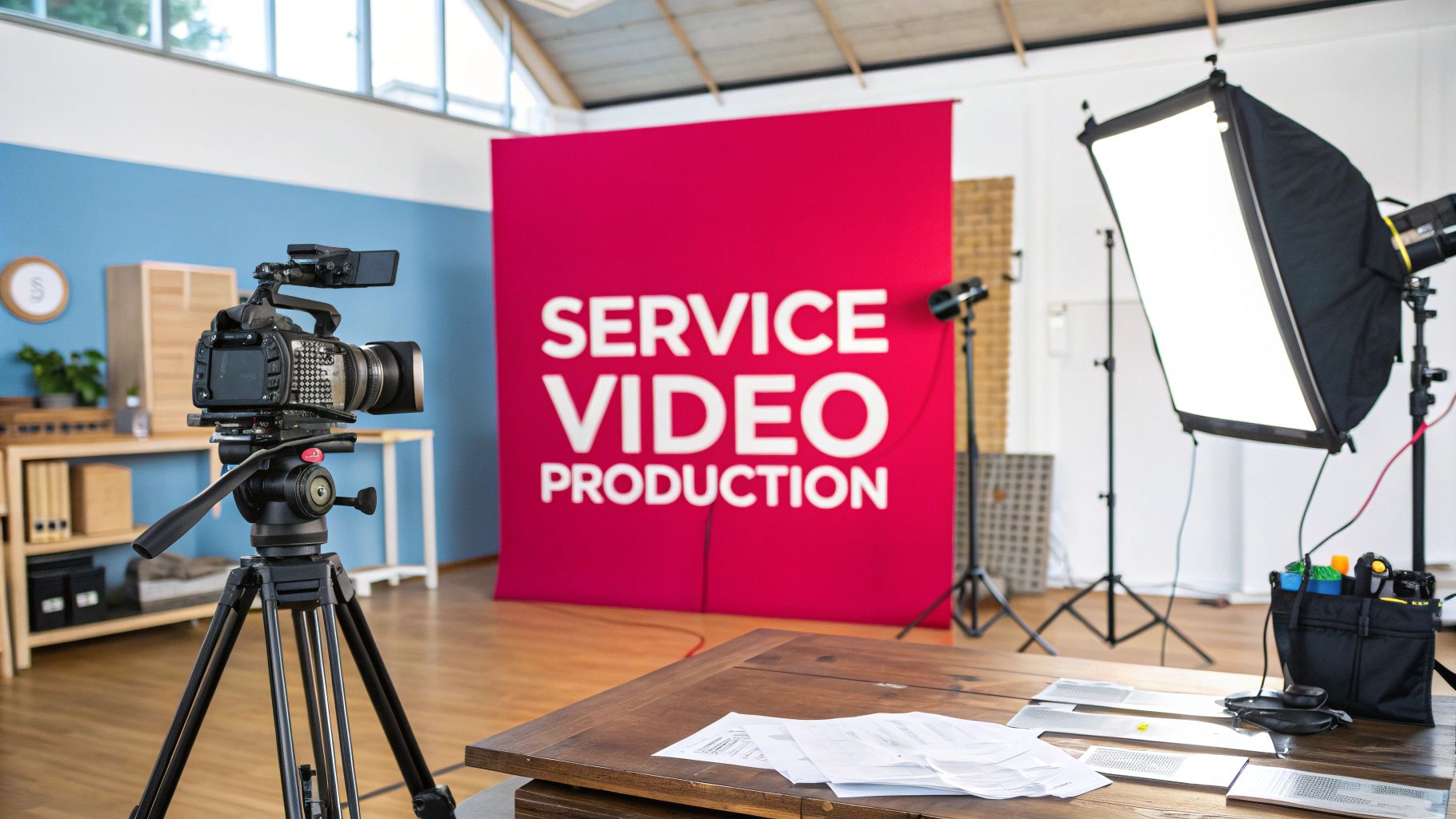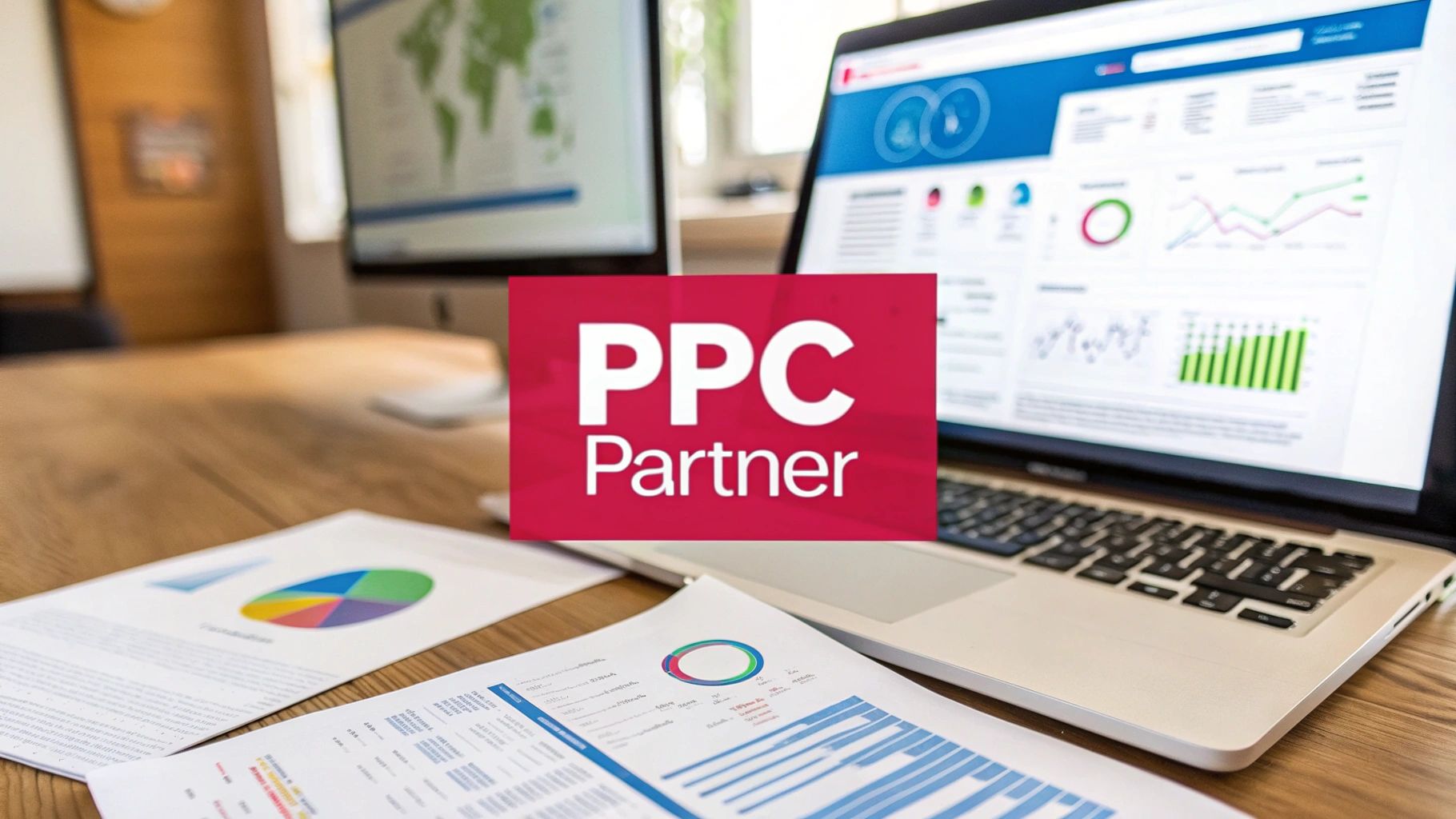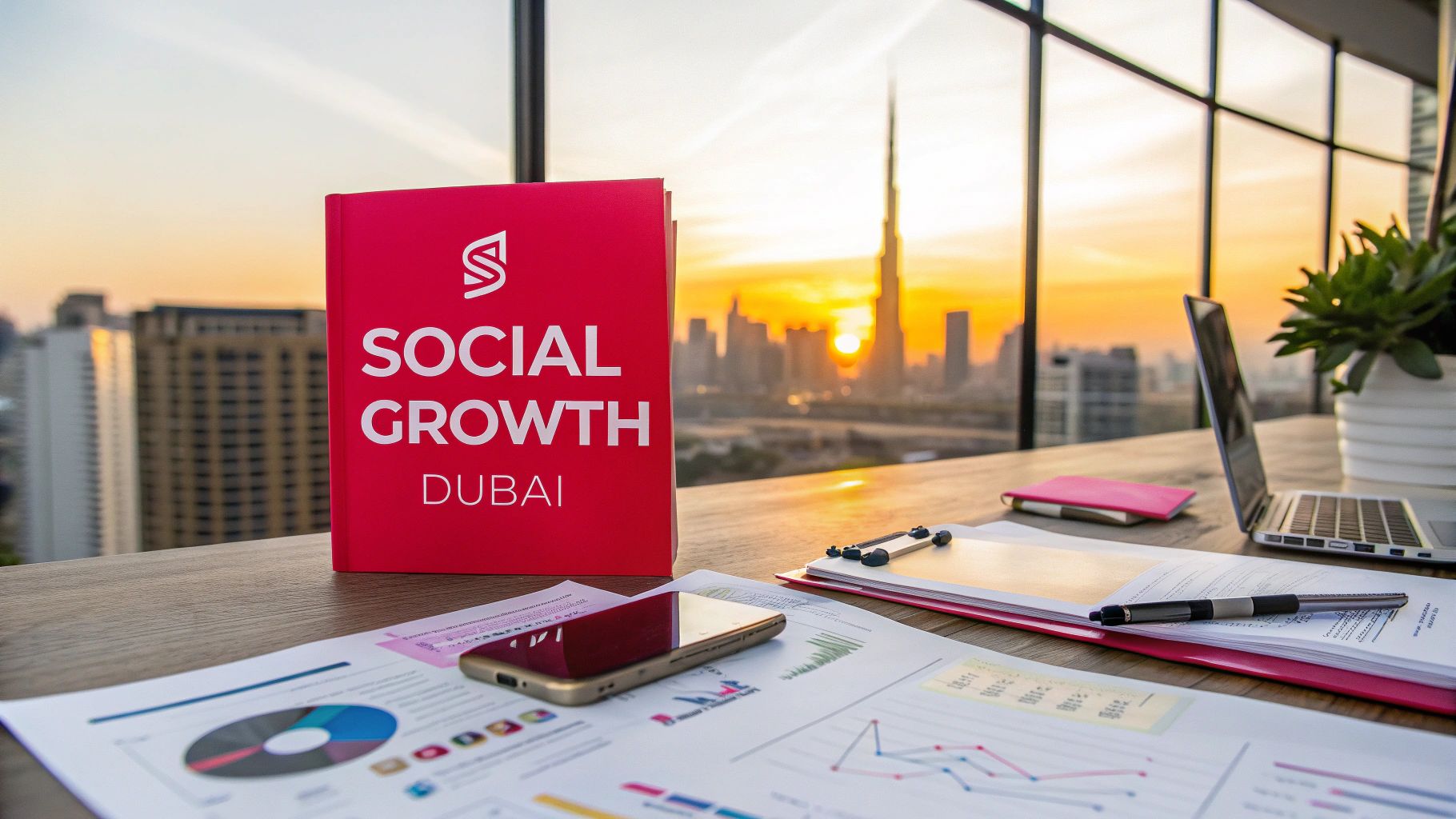A great Dubai ecommerce website design isn't just about beautiful visuals and slick animations. The real magic, the kind that leads to actual sales, happens long before you even think about colour palettes. It all starts with a solid, strategic foundation built on a deep understanding of the local market.
You need to know who you're selling to, what your competitors are up to, and what makes your brand special enough for Dubai's savvy shoppers to choose you.
Laying the Groundwork for Ecommerce Success in Dubai
Before you jump into the fun stuff like design mockups, let's talk strategy. The UAE's e-commerce scene isn't just growing—it's booming. This rapid expansion is fantastic news for new businesses, but it also means the competition is fierce. You can't just throw up a website and expect sales to roll in. A strong foundational plan is absolutely essential.
The chart below gives you a clear picture of just how fast this market is expanding.
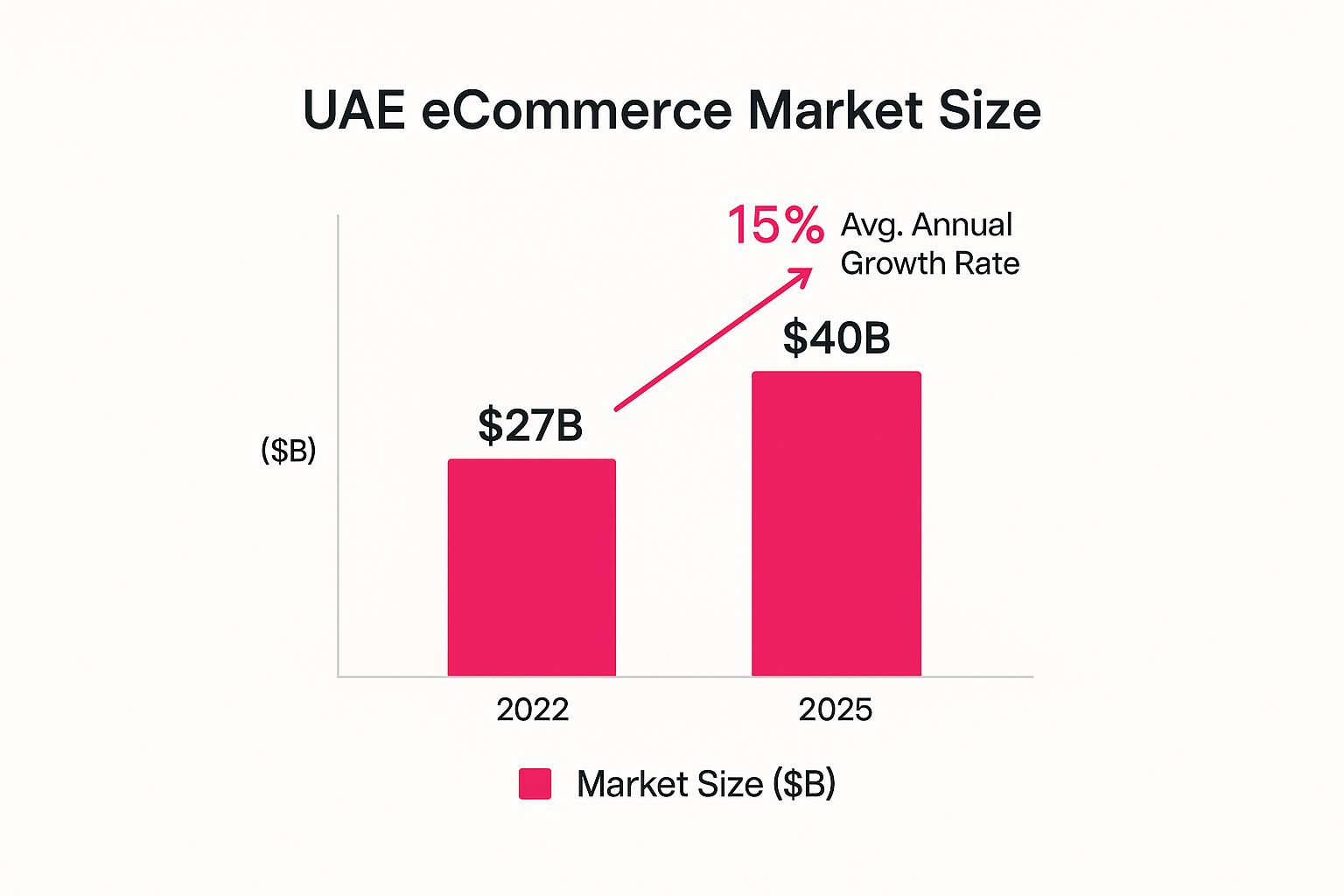
The takeaway here is simple: the opportunity is massive, but only for those who come prepared. Your goal is to be one of them.
Nail Down Your Niche and Audience
So, who are you selling to? If your answer is "everyone in Dubai," you need to go back to the drawing board. This city is a unique blend of high-net-worth locals, expats on a budget, and young, tech-forward professionals. A brand selling high-end luxury watches needs a completely different approach than one offering organic baby food.
To get this right, you have to ask some tough questions:
- What specific problem am I solving for a specific group of people? This is your unique selling proposition (USP).
- Who is my perfect customer? Get detailed. Think about their lifestyle, income, and what they value in an online shopping experience.
- Where are they hanging out online? Your marketing plan depends on this—are they on Instagram, TikTok, or searching on Google?
Getting this clarity ensures your dubai ecommerce website design feels like it was made just for them.
Size Up the Competition
Once you know your audience, it's time to see who's already got their attention. Find your top 3-5 competitors in the Dubai market and do more than just a quick browse of their sites. Become a detective.
Expert Tip: A smart competitor analysis isn't about imitation. It's about finding the cracks in their armour. Look for clunky user experiences, products they should have but don't, or customer service complaints. These are the gaps where your business can shine.
The numbers don't lie. The UAE's e-commerce market is set to skyrocket from $12.28 billion in 2025 to a staggering $21.18 billion by 2030. This growth is fueled by an incredible 99% internet penetration rate. With mobile commerce making up 44% of all transactions, a lightning-fast, mobile-first design isn't just nice to have; it's a requirement for survival.
This initial groundwork sets you up for one of the biggest early decisions you'll make: choosing your e-commerce platform. The choice between a ready-made platform and a custom-built site has major implications. To dig deeper, check out this excellent comparison of Shopify vs. Custom Website development.
Choosing the Right E-commerce Platform
Selecting the right platform is a critical step that will impact everything from your day-to-day operations to your ability to scale. For the Dubai market, you need a platform that can handle local nuances like language and payment methods.
Here’s a quick comparison to help you weigh your options:
Key Ecommerce Platform Comparison For The Dubai Market
| Platform | Best For | Local Payment Support | Multi-Lingual Ready | Pricing Model |
|---|---|---|---|---|
| Shopify | Startups & SMEs looking for a quick, user-friendly setup. | Excellent. Integrates with Telr, PayTabs, Checkout.com. | Yes, through apps and themes. | Monthly Subscription |
| WooCommerce | Businesses wanting full control and customisation on WordPress. | High. Many plugins for local gateways. | Yes, via plugins like WPML. | Free (but requires hosting/paid plugins) |
| Magento | Larger businesses with complex catalogues and scalability needs. | Strong. Native and third-party integrations available. | Excellent native support. | Open Source (free) & Commerce (paid) |
| Custom Build | Enterprises needing unique features and integrations. | Completely customisable to any payment gateway. | Fully customisable for any language. | High Upfront Cost |
Ultimately, the "best" platform depends entirely on your business model, budget, and long-term goals. While platforms like Shopify offer speed and simplicity, a custom solution provides unparalleled flexibility.
For a more detailed breakdown tailored to the region, our complete guide on e-commerce website development in Dubai offers even more expert insights to help you make the right choice.
Crafting an Experience Dubai Shoppers Will Love
In a market as dynamic and competitive as Dubai, your website's design isn't just window dressing—it's the very foundation of your business. A clunky, confusing site is the quickest way to send potential buyers straight to your competitors. The goal isn't just to build a website; it's to create an online journey that feels so intuitive and seamless that shoppers glide from browsing to buying without a single moment of frustration.
It all starts with making the experience feel effortless. Customers expect to find what they're looking for almost instantly. If they have to hunt for a search bar or wrestle with complicated category menus, they’re gone. This makes clean, logical navigation your absolute first priority.
Nailing the Dubai Aesthetic
Visuals are your first handshake with a potential customer, and in Dubai, aesthetics are everything. They build trust and create desire, especially with a shopper base that’s both high-end and brand-aware. While design trends are always shifting, a specific look tends to resonate well here: a sophisticated blend of minimalism and luxury.
Think about these core visual elements:
- Colour Palette: You can't go wrong with soft, elegant palettes. Imagine matte blacks, crisp whites, or muted earth tones brought to life with a subtle accent of gold or bronze. This combination signals a premium brand without shouting.
- High-Quality Imagery: This one is non-negotiable. Grainy, poorly lit photos will instantly cheapen your products and your brand. You must invest in professional photography and videography to show your items in their best light. It's an investment that pays for itself.
- Typography: Fonts need to be clean, modern, and incredibly easy to read across all devices, especially mobile. Legibility is a silent hero of good user experience.
Your visual design should scream quality before a visitor even reads a single product description. It sets the tone for everything that follows.
Building Product Pages That Actually Convert
This is where the magic happens. Your product pages are the final sales pitch, the place where a browser becomes a buyer. A great page anticipates and answers every question, removing all friction and doubt from the customer's mind. Every single element should work together to lead them toward that "Add to Cart" button.
The secret to a high-converting product page is simple: answer every question before the customer even thinks to ask it. From sizing charts and material composition to shipping timelines and return policies, clarity is what gives people the confidence to click "buy."
In a market projected to soar past $12 billion by 2025, you can't afford to get this wrong. With over 98% of the population using the internet daily, a flawless user experience isn't just a nice-to-have; it's essential for survival. To get a deeper understanding of how design choices affect your budget and ultimate success, check out this detailed guide on building an eCommerce website in Dubai.
Streamlining Your Checkout for More Sales
The checkout is the final hurdle, and it’s astonishing how many sales are lost right here. A long, convoluted checkout is the number one cause of abandoned carts. Your mission is to make this last step as fast and painless as humanly possible.
Here are a few battle-tested tips I always give my clients:
- Always Offer Guest Checkout: Forcing someone to create an account is a notorious conversion killer. Let them buy quickly and easily.
- Aim for a Single Page: If you can, fit the entire checkout process onto one clean page. Fewer clicks mean a faster, happier experience.
- No Surprise Costs: Be transparent about all costs—including shipping and any taxes—from the very beginning. Last-minute surprises are a major turn-off.
- Provide Local Payment Options: Don't just offer standard credit cards. Integrating popular local payment gateways shows you understand the market and cater to everyone.
By focusing intently on these crucial UX and UI details, you'll be building more than just a good-looking Dubai ecommerce website design. You’ll be creating an efficient, powerful sales machine.
Making Your Store a Perfect Fit for the UAE Market
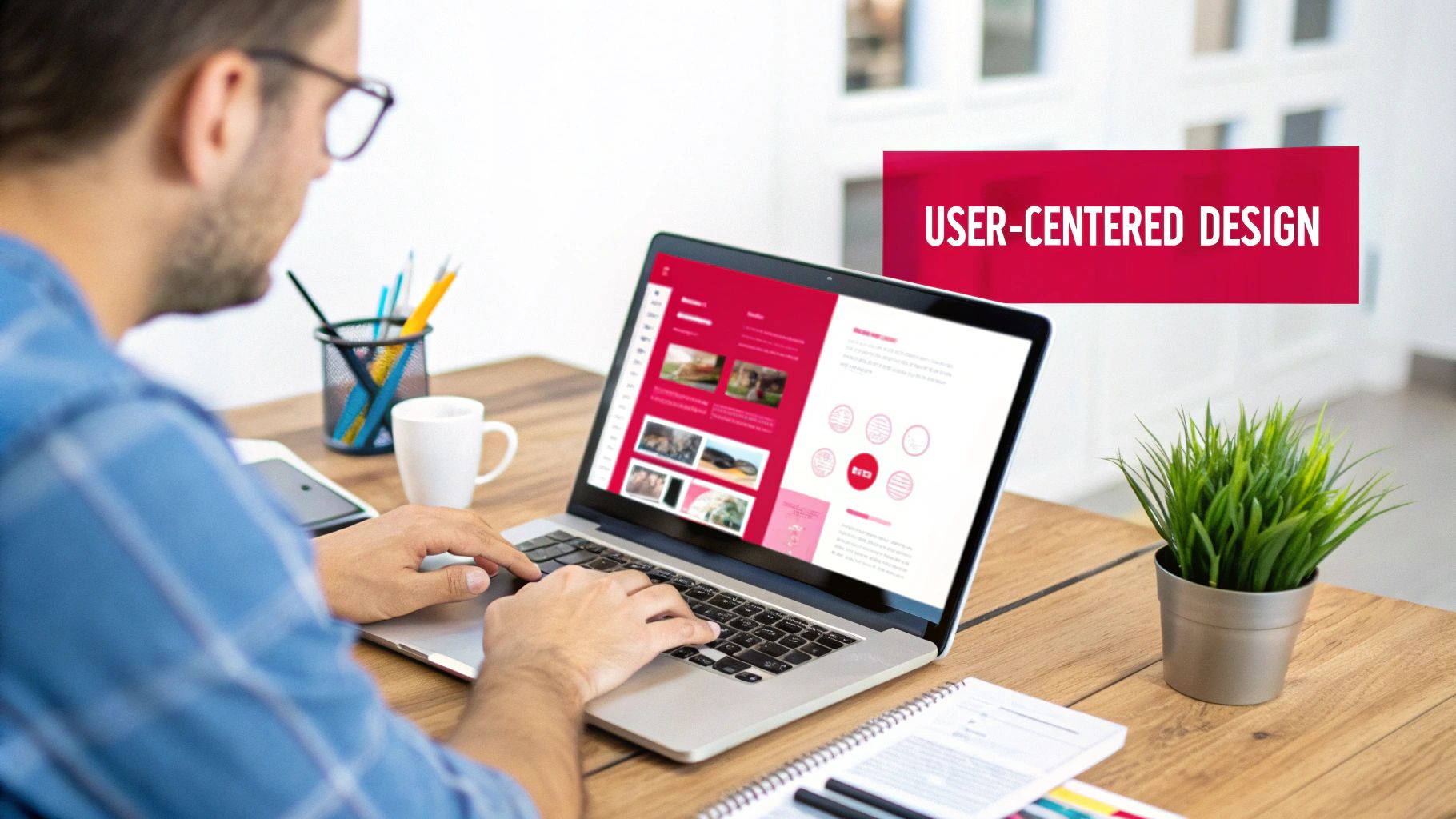
If you launch a generic, one-size-fits-all e-commerce site in Dubai, it's dead on arrival. To actually connect with customers here and build a business that lasts, you have to mould your store to fit local expectations. This is what we call localisation, and it’s about so much more than just translation. It's about earning trust and proving you get the market.
Think of it this way: effective localisation is the secret ingredient for every top-performing online store in the region. It shows shoppers you’re a serious, professional brand that respects their culture. Honestly, this is a non-negotiable part of a successful https://grassrootscreativeagency.com/ecommerce-website-design-uae/ and crucial for any real growth.
An Arabic Website Is More Than a Toggle Switch
Providing a full Arabic version of your site is ground zero. But this is where so many brands stumble right out of the gate. A cheap, machine-generated translation just won't cut it. You'll end up with clunky phrasing and cultural blunders that can seriously tarnish your brand's reputation before you even get started.
You need a professional, culturally sharp translation that feels completely natural to a native speaker. This means getting a few key things right:
- Right-to-Left (RTL) Layout: It’s not just the words that need to flip. Your entire website design—menus, images, buttons, the whole lot—has to be reconfigured to support the right-to-left reading direction of Arabic.
- Cultural Nuance: All your product descriptions, marketing messages, and even your photography must be vetted. You need to make sure they align with local values and sensitivities. What's perfectly normal in a Western market might not fly here.
- Local Language and Phrasing: Sprinkling in common Gulf-region terminology and expressions makes your brand feel far more authentic and relatable.
Offer Payment Methods That Inspire Confidence
How your customers pay is just as critical as what they're buying. Of course, you need global mainstays like Visa and Mastercard, but stopping there is a huge mistake. Integrating payment methods that are familiar and trusted locally sends a powerful message that you're truly invested in the market.
A huge piece of the puzzle is integrating the common payment methods in the UAE that shoppers here know and use daily.
My Two Cents: You absolutely need a mix of payment options. This should include international credit cards, local debit cards, and the wildly popular Buy Now, Pay Later (BNPL) services like Tabby and Tamara. These BNPL platforms are a massive hit with younger, tech-savvy shoppers.
And whatever you do, don't underestimate the power of Cash on Delivery (COD). Even in a digitally advanced place like the UAE, a huge slice of the population still prefers COD. It removes any perceived risk of paying online. Yes, it adds logistical hurdles for you, but not offering it means you're walking away from a massive chunk of potential sales.
Getting Logistics and Shipping Right
Finally, your localisation efforts have to carry all the way through to fulfilment. Shoppers in Dubai and across the UAE expect fast, reliable delivery. It's a demanding market. Next-day, and sometimes even same-day, delivery is the new standard, not a luxury.
Be completely upfront about shipping costs and delivery times, right on your product pages and throughout the checkout process. Nothing sours a customer experience faster than surprise fees or unexpected delays. Clearly stating your policies on shipping, returns, and any customs duties is how you build the trust that brings customers back again and again.
Using Personalisation to Stand Out in Dubai
Let's be honest: in Dubai's packed digital marketplace, a generic, one-size-fits-all storefront is invisible. To actually capture shoppers' attention and, more importantly, their loyalty, you have to build an experience that feels alive, intelligent, and designed just for them. This is where you move beyond basic features and start using smart tools that truly connect with your customers.
The whole idea boils down to using customer data—responsibly, of course—to make every click and every visit meaningful. When you analyse browsing history, past purchases, or even what someone left in their cart, your site can suddenly offer up recommendations that feel genuinely helpful, not just like a sales pitch from a robot.
Think about it from a customer's perspective. They log in and get a "Welcome Back" offer tailored to them, or someone browsing from Abu Dhabi instantly sees shipping details relevant to their emirate. That's how your dubai ecommerce website design transforms from a static product catalogue into a smart, responsive shopping assistant.
Dynamic Content and Smart Suggestions
Real personalisation is much more than just a "you might also like" section at the bottom of a product page. It means the website itself changes based on who’s looking at it, creating a smoother, more relevant path to purchase for every single person.
Here are a few powerful ways to bring this to life:
- Location-Based Offers: Why not show promotions or highlight products that are trending in a user's specific city, whether it's Dubai, Sharjah, or anywhere else in the UAE?
- Loyalty-Tier Content: Reward your best customers. Show exclusive discounts, give them early access to new collections, or display special banners that only they can see.
- Behavioural Pop-Ups: Someone about to leave your site with a full cart? That’s the perfect moment to trigger an exit-intent pop-up with a unique discount code to nudge them over the finish line.
This isn’t just a nice-to-have anymore; it's becoming a requirement. A major trend shaping Dubai's e-commerce scene for 2025 is this deep dive into personalisation to drive engagement. By analysing browsing patterns and purchase history, websites can dynamically adjust what each visitor sees. For example, a returning customer might find loyalty discounts on the homepage, while someone on a phone gets a faster, app-like experience. You can get more insights on how these design trends are boosting conversions at risianstechnology.com.
When you make the shopping experience feel familiar and tailored, you build a powerful sense of trust. It's a proven fact: personalised recommendations dramatically increase repeat purchases and lower bounce rates.
The Rise of AI and Visual Search
Beyond data, newer technologies are adding another layer of personal touch. An AI-powered chatbot, for instance, offers instant, 24/7 support. It can answer common questions, track an order, or even suggest products in a natural, conversational way.
Another feature that's a real game-changer is visual search. Imagine a customer sees a handbag they love on the street. They can snap a photo, upload it to your site, and instantly see similar items from your inventory. It’s intuitive, incredibly fast, and solves the problem of not knowing the right keywords to search for. These are the kinds of features that make shoppers say "wow" and keep them coming back for more.
Marketing And Optimising Your Store After Launch

Getting your e-commerce store live is a huge milestone, but it's the starting line, not the finish. The initial excitement is fantastic, but what you do in the days and weeks after launch is what truly builds a lasting business. A brilliant Dubai e-commerce website design is only half the battle; people actually need to find it.
This is where the real work begins. It’s a constant loop: drive traffic, see how people behave, and use that data to make smart changes that improve the experience and, ultimately, your sales.
Driving Targeted Traffic With Local SEO
For any Dubai-based e-commerce brand, showing up on Google.ae is non-negotiable. This is where your most motivated customers are looking. Local SEO is your best friend here, helping you appear in front of people in Dubai who are actively searching for what you sell.
It’s about more than just keywords. You need to signal your local relevance to Google. Think like a local. Instead of just "gift delivery," optimise for phrases like "same-day gift delivery in Dubai Marina" or "organic skincare Jumeirah."
Don't forget to set up and meticulously maintain your Google Business Profile. Keep your details current, actively encourage customer reviews, and share regular updates. This builds immense trust with both Google and your future customers.
I always tell new store owners this: treat local SEO as a long-term project. The consistent effort you put into locally-focused content and gathering positive reviews will pay dividends, cementing your site's authority in the Dubai market.
Mastering The Right Digital Marketing Channels
While SEO is your foundation, you can't just wait for people to find you. You have to go where your audience is. In Dubai, that means getting very good at visual, engaging social media.
- Instagram & TikTok: These aren't just for posting pretty pictures. They are serious sales channels. Think high-quality product shots, collaborations with local influencers, and shoppable posts that make it easy for someone to go from scrolling to buying.
- Paid Advertising: The targeting capabilities on Meta (Facebook & Instagram) and Google Ads are incredible. You can zero in on specific demographics, interests, and even past purchase behaviours, making sure every dirham of your marketing budget works hard for you.
- Email & WhatsApp Marketing: Building a direct line to your customers is priceless. Start collecting emails from day one to share promotions, announce new arrivals, and win back past customers. In this region, WhatsApp marketing is also a game-changer for sending quick order updates and exclusive deals.
If you want to truly get the most out of these platforms, exploring professional social media management in Dubai can give you a real competitive advantage.
Using Analytics to Fuel Growth
Your website analytics are a goldmine. Tools like Google Analytics and Hotjar show you the real story of how people use your site. You can see where they came from, which pages they looked at, and exactly where they gave up and left.
Checking this data isn't a "nice-to-have"—it's essential. It’s how you find the roadblocks, like a checkout process that’s too complicated or a product page that loads too slowly. It also shows you what's working. Maybe one blog post is bringing in a ton of sales, or visitors on mobile are leaving a specific page in droves. This data takes the guesswork out of improving your store, letting you make confident, data-backed decisions that lead to real growth.
Common Questions About Dubai Ecommerce Design
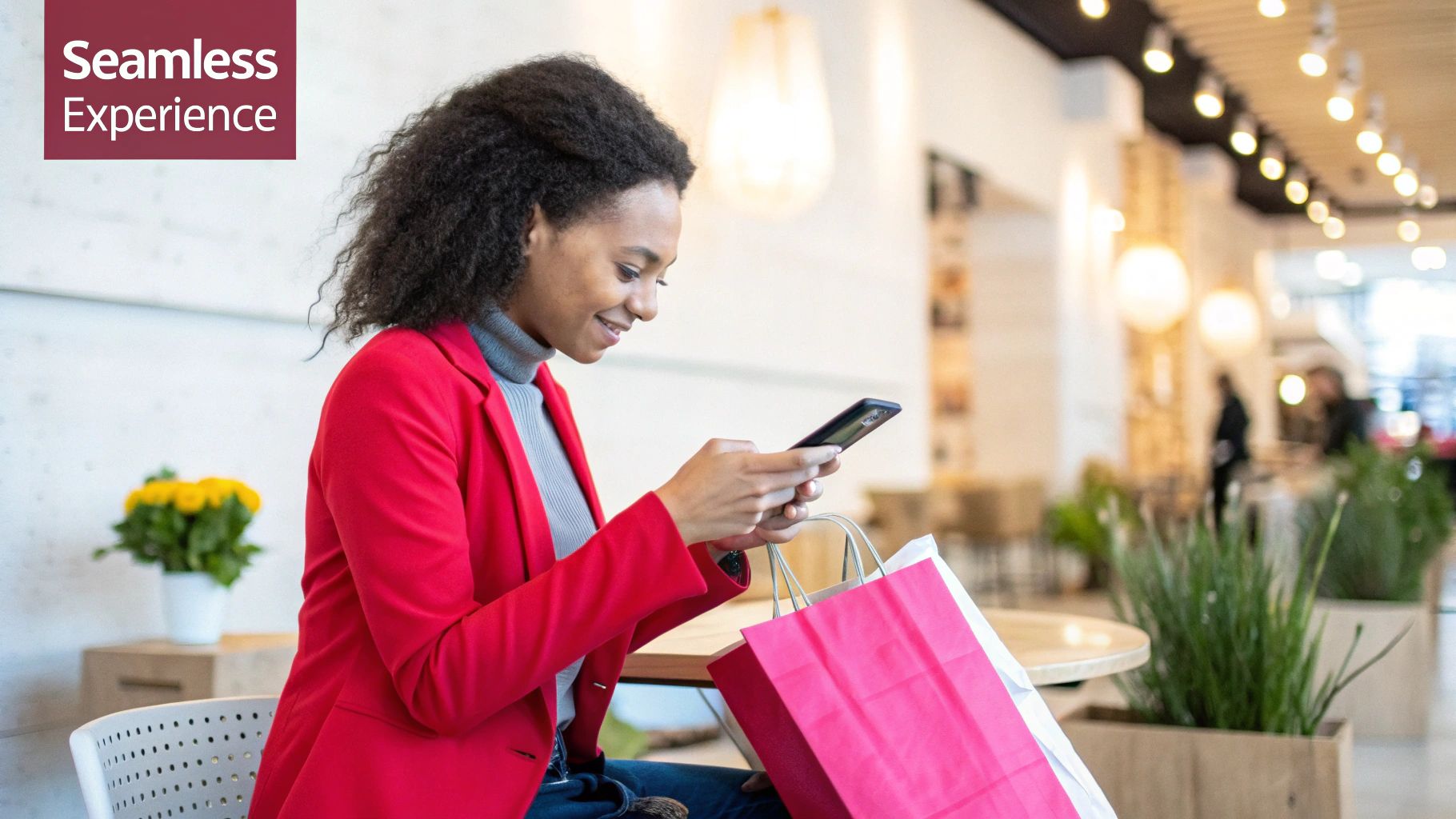
As you start planning your online store for the Dubai market, you're bound to run into some specific questions. It's a unique retail environment with its own set of rules and customer expectations. Based on our experience, here are some of the most common things entrepreneurs ask when they're getting started.
How Much Does An Ecommerce Website Cost In Dubai?
This is usually the first question on everyone's mind, and the honest answer is that the cost can range dramatically. There’s no single price tag.
For a simple store using a pre-built template on a platform like Shopify, you might be looking at a starting setup cost of a few thousand dirhams. On the other hand, if you need a fully custom Dubai ecommerce website design with specialised features, complex system integrations, and a completely unique brand identity, the investment will be substantially higher.
It all boils down to a few key decisions:
- Platform Choice: A user-friendly platform like Shopify is often more budget-friendly upfront. A more powerful, custom-coded solution on a platform like Magento (now Adobe Commerce) or a completely bespoke build requires a larger investment but offers more flexibility.
- Design Complexity: A clean, elegant site built on a premium template is a smart, cost-effective choice. If you're aiming for a highly interactive experience with custom animations and unique user journeys, expect the design and development costs to rise accordingly.
- Feature Set: The more you add, the more it costs. Advanced features like AI-powered product recommendations, integrated loyalty programmes, or detailed customer analytics will add to your final bill.
Do I Really Need Both English And Arabic Versions?
Yes, without a doubt. While you can technically get by with just English, you'd be ignoring a huge and valuable part of the local market. Offering a professional Arabic version of your site isn't just about translation; it's about showing respect and commitment to the region.
A professional, right-to-left (RTL) optimised Arabic site tells customers you're a serious local business. A cheap, clunky machine translation will do more harm than good, eroding trust before you've even made a sale.
Think of it as an investment in credibility. It's one of the clearest signals you can send that your brand is here to stay.
What Is The Most Important Design Element For Dubai Shoppers?
Aesthetics are important, but the single most critical factor for success is flawless mobile responsiveness.
Shoppers in the UAE live on their phones. They browse, research, and—most importantly—buy using their mobile devices. If your website is slow to load on a 4G connection, has tiny buttons that are impossible to tap, or requires endless pinching and zooming, you’ve already lost the sale. It's that simple.
Your site must be fast and intuitive on a smartphone. This isn’t a nice-to-have feature; it's the absolute foundation of your online store. High expectations and low patience are the names of the game here, so adopting a mobile-first design mindset from day one is non-negotiable.
Ready to build a powerful e-commerce store that resonates with the Dubai market? The team at Grassroots Creative Agency combines data-driven strategy with bold creative to build websites that don't just look good—they sell. Let's start building your digital presence today at https://grassrootscreativeagency.com.


